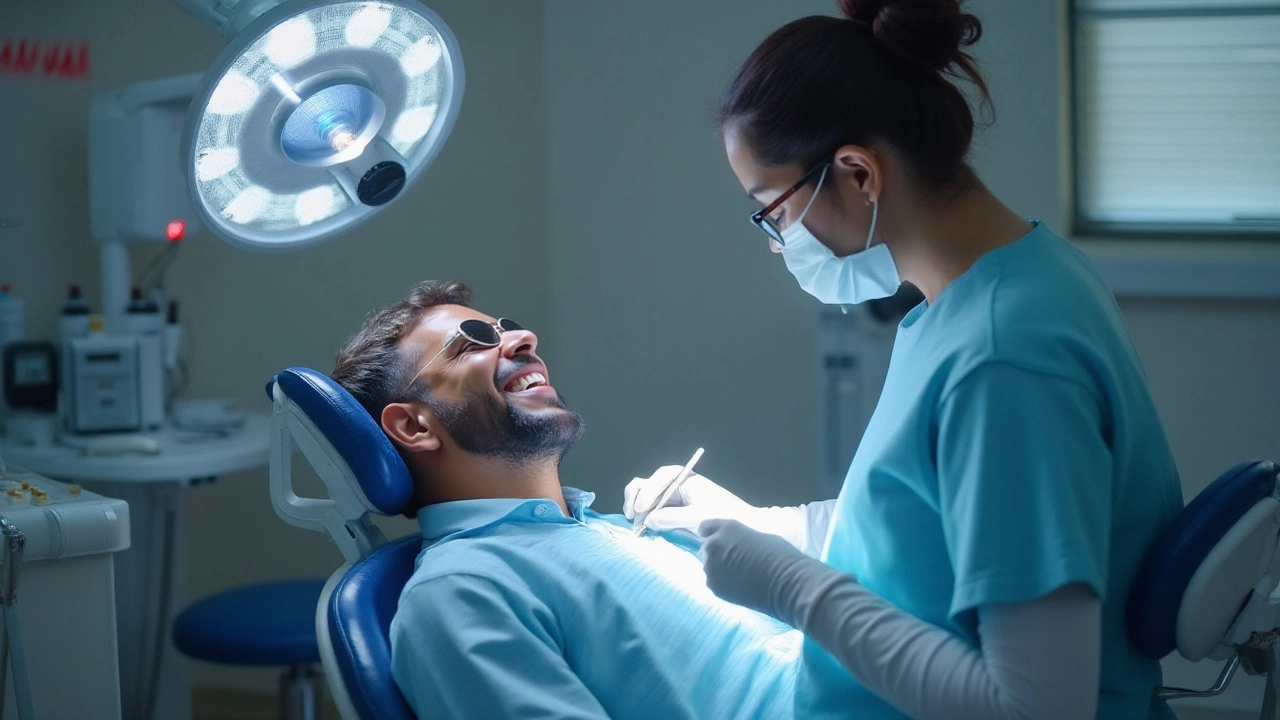Understanding the Timeline for Dental Implant Acceptance
 Jan, 29 2025
Jan, 29 2025
Embarking on the journey of dental implants is a significant decision for anyone seeking a permanent tooth replacement solution. But how long does it really take for your body to accept a dental implant? This process is not just about the time spent in the dental chair; it involves stages that require patience and care.
Each phase—from the surgical placement of the implant to the osseointegration period where the implant fuses with your jawbone—can vary significantly depending on individual circumstances. This article will guide you through these stages, offering insights into what you can expect and how best to facilitate a healthy recovery.
- The Initial Surgery
- Healing and Osseointegration
- Factors Influencing Acceptance
- Tips for a Smooth Recovery
The Initial Surgery
The initial surgery for a dental implant is a well-orchestrated procedure that lays the groundwork for your new artificial tooth. It begins with a thorough examination and imaging, usually involving X-rays or 3D scans to assess the health of your jawbone and to meticulously plan the placement of the implant. The procedure itself is typically performed under local anesthesia, with sedation options available for those who might need additional comfort. The dentist makes an incision in the gum to expose the bone, followed by a precise drilling process where the implant post, often made of titanium, is carefully inserted. This stage is crucial as the positioning of the implant can significantly affect the success of the osseointegration process.
Once the implant is in place, the gum is sutured back over the implant post. This marks the beginning of the healing phase, but the body has already started its acceptance journey. Dental implants boast a remarkable success rate, often cited as 95% or higher, which underscores the reliability of this procedure when performed by skilled professionals.
"Dental implants are today considered the gold standard of care for prosthetic replacement of missing teeth in dentistry," says Dr. Lisa Heitz-Mayfield, an esteemed periodontist.During this stage, some patients may experience mild discomfort, swelling, or bruising, which typically resolves within a few days. The dentist will provide a comprehensive post-operative care plan to help manage these symptoms and ensure a smooth healing process.
Healthy patients with robust bone conditions often find that their bodies begin the integration process fairly swiftly. However, several factors can influence this initial stage, such as smoking habits, chronic conditions like diabetes, and the quality of oral hygiene. Interestingly, studies have shown that patients who actively manage these factors can help accelerate recovery and improve the outcome of the implant. Surgeons may also prescribe antibiotics or recommend antiseptic mouthwash to prevent infection. Understanding these aspects helps set realistic expectations and prepares you mentally and physically for the journey ahead.
The immediate aftermath of the surgery often requires adherence to a soft diet, avoiding hard or crunchy foods that might disturb the implant site. This is crucial as the initial stability, known as primary stability, of the implant can influence the eventual success of the treatment. The surgeon's precision during the placement ensures that the load bearing undertaken by the implant remains uniformly distributed, minimizing any potential risks. Patients are advised to return for follow-up appointments that usually occur within a week post-surgery to remove stitches and assess the healing progress.
In rare cases where the existing bone is insufficient to support an implant, additional procedures such as bone grafting might be recommended. This involves using a donor bone to build up the jaw structure, thereby creating a more secure foundation for the implant. Although it adds time and complexity to the procedure, it significantly enhances the potential for a successful and robust implant. A detailed discussion with your dental surgeon will outline these possibilities, ensuring you have a clear understanding of the tailored plan for your dental health.

Healing and Osseointegration
The journey of a dental implant successfully integrating with your jawbone is a fascinating and crucial phase known as osseointegration. This period is the cornerstone of the implant's stability and functionality, much like setting the foundation of a new building. Initially, after the implant surgery, your body begins an intricate healing process. The surgical site might feel tender, and slight swelling or discomfort could occur, as it’s part of the body’s natural response to healing. During the first couple of weeks, the wound heals superficially while the implant integrates at a deeper level. It's vital to follow your dentist's post-op instructions meticulously, as this can significantly impact the speed and efficacy of healing.
Osseointegration is a unique biological process where the titanium implant bonds with the jawbone. This integration usually takes several weeks to several months, often depending on overall health, age, bone quality, and even lifestyle choices, like smoking or improper oral hygiene. For many, this timeline might seem long, but the result is a robust union that mimics the natural root of a tooth. The term itself, coined by Professor Per-Ingvar Brånemark, refers to the bone’s ability to grow and support the implant fixture without the formation of fibrous tissue. Known as the "Father of Modern Dental Implantology," Brånemark's revolutionary discovery dates back to the 1950s and has since transformed dental care.
It's essential to recognize that each individual's healing timeline may differ. Some might experience quicker integration, whereas others might need more time, particularly if additional procedures like bone grafts are involved. Studies suggest that approximately 95% of implants succeed when adequate conditions and care are established. These impressive statistics underscore the importance of the initial healing period. Ensuring optimal oral hygiene and attending regular follow-ups can significantly enhance the body’s acceptance of the implant, paving the way for enduring results. Moreover, being informed about dietary choices and avoiding certain habits can further facilitate a seamless osseointegration process.
Reflecting on personal experiences, many have found that patience and adherence to professional advice are key to a successful implant journey. "Healing requires patience and intention," reflects Dr. Maria Lopez, a prominent dental surgeon in her field. "Understanding each stage of osseointegration empowers patients to take an active role in their recovery." Taking this wisdom to heart, it’s clear that while the process might seem slow, the payoff in longevity and quality of life is often well worth the wait. Remember, your commitment during this healing time is an investment in future dental health.

Factors Influencing Acceptance
When considering the success of a dental implant, various factors come into play that can either hasten or delay the body’s acceptance of the fixture. The integration process, known scientifically as osseointegration, is crucial as it determines whether the implant becomes a permanent part of your jaw. One of the primary influencers of this process is bone density. People with stronger, denser jawbones typically experience faster healing times as the bone readily bonds to the implant surface.
Another critical factor is oral health. Maintaining pristine oral hygiene is not optional—it's mandatory. Bacteria thrive in the mouth, and if allowed to colonize around the implant site, they can lead to peri-implantitis, an infection that can severely compromise healing. Those with existing gum disease or inadequate dental care may need extra attention from dental professionals to ensure a successful recovery.
Interestingly, lifestyle habits play a pivotal role as well. Smoking, for example, has been shown to double the risk of implant failures. The nicotine constricts blood vessels, impairing the blood flow that’s essential for healing. A smoker may face delays in osseointegration and a higher chance of rejection. On the flip side, patient commitment to following post-surgical care instructions can dramatically improve outcomes. Simple changes, like a healthier diet rich in vitamins and minerals, particularly vitamin D and calcium, support bone health tremendously.
The body's biological response to surgery is uniquely individual, affected by systemic health conditions such as diabetes and autoimmune disorders. These conditions can slow down healing processes and require personalized treatment plans. In a study by the American Dental Association, it was revealed that nearly 5% of implant patients have underlying health issues impacting recovery times. Understanding these conditions' influence on your dental health is crucial for anticipating and navigating potential setbacks.
Importance of Material and Technique
Not all implants are created equal. The materials used, mainly titanium or zirconia, have different properties that can affect the healing process. Titanium, renowned for its biocompatibility, is widely used due to its success in fusing with bone structures. However, new materials like zirconia are gaining popularity for those with metal sensitivities. The choice between these should be made with advice from professional dentists comfortable with each technique.
The surgical technique may also influence recovery. Advanced methods such as computer-guided surgery ensure precision in placement, reducing trauma to the surrounding tissues and potentially speeding up the body’s acceptance. Innovations in implant surface technology can also play a part. Some studies suggest that rougher surfaces on implants might enhance the bone cells' attachment, potentially improving integration times.
"The success of a dental implant doesn't rest solely on the surgeon's skills but also on the body's willingness to incorporate it as its own," said Dr. Helen Morton of the Global Dental Alliance during an interview on modern dental practices.
By understanding these varied factors, patients can better prepare and adjust their expectations throughout their dental implant journey. It’s about collaboration between the dental team and the patient, forming a partnership that leads to the ultimate goal—successful, lifelong integration.

Tips for a Smooth Recovery
Recovering from a dental implant procedure does require a good amount of care and understanding. Ensuring a smooth recovery involves paying close attention to several aspects of your daily routine. One of the first and perhaps most critical steps post-surgery is managing discomfort. Pain, swelling, and a little bleeding are normal during the initial few days. It's vital to follow your dentist's instructions for managing these symptoms, and prescription medications should be taken as directed. Keeping ice packs handy can help reduce the swelling significantly, typically within the first 48 hours.
Adopting a temporary diet change can also play a pivotal role in the healing process. Soft foods will be your best bet immediately after the surgery. Soups and smoothies are both nutrient-rich and easy on the surgical site. Avoid hard, crunchy, or sticky foods which could disrupt the *dental implant* healing process. This dietary adjustment is essential as it minimizes stress on the newly placed implant, giving the area time to heal without undue pressure or irritation. Hydration is another crucial aspect; however, refrain from using straws as the suction can disturb your gum line.
Dental hygiene is paramount during recovery, even though it might seem challenging with a swollen and sensitive mouth. Gentle cleaning of the other teeth should not be neglected, and special care should be employed around the surgical site. Using an antimicrobial mouthwash can help in maintaining oral hygiene, reducing the risk of infection. Speaking of hygiene, remember that smoking can drastically hinder blood circulation to the surgical area, slowing down the recovery process. If you're a smoker, consider this a good time to quit, or at the very least, abstain for a few weeks to optimize healing.
Routine post-operative check-ups are instrumental in a complication-free recovery. Your dentist will need to monitor the progress of the implant integration into the jawbone, known as *osseointegration*. Keeping these appointments is non-negotiable as they ensure the healing is progressing as expected. Any signs of anomalies like excessive pain, swelling, or a loose implant should be promptly addressed. Ignoring these symptoms could lead to implant failure.
It’s also important to maintain a healthy lifestyle during recovery. Adequate rest can accelerate the healing process as it allows your body to use its resources effectively to heal and regenerate. If you're a fan of vigorous exercise, it's best to take it slow for a couple of weeks. Overexertion can lead to increased blood pressure, which might worsen bleeding at the surgical site. Listening to your body and giving it time to recover is key.
"Following your post-operative care procedures meticulously not only aids in recovery but significantly improves the success rate of dental implants," says Dr. Emily Lowry, a renowned oral surgeon with two decades of experience. "Patience and diligence during this phase can lead to a lifetime of benefits."
Additional Tips for Enhanced Healing
One of the lesser-known tips includes engaging in certain exercises aimed at improving facial muscle mobility. This is especially beneficial if you notice stiffness due to the surgery. Consult your dentist or oral physiotherapist for suitable exercises. Such exercises can aid in reducing facial swelling and improving nutrient flow, thereby promoting faster healing.
- Follow-Up Care: By no means should final check-ups be dismissed. They play an essential role in assessing long-term implant success.
- Custom Dietary Plans: If you have specific nutritional needs, seek guidance to ensure your diet not only aligns with your recovery goals but also supports your overall health.
- Mindfulness and Stress Management: Lastly, keeping stress at bay can enhance your body’s healing capabilities. Stress has been shown to negatively affect immune response, so consider adopting mindfulness practices or gentle activities such as yoga.
Healing from a dental implant surgery is a partnership between patient and professional care providers. By incorporating these tips into your recovery plan, you'll be on the right path to a healthy and strong new smile.